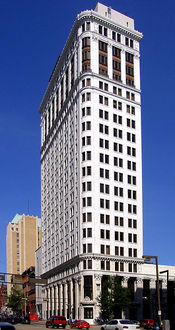John A. Hand Building
The John A. Hand Building (Built as the American Trust and Savings Bank Building, then renamed the American-Traders National Bank Building, and First National Bank Building, before being renamed to honor John A. Hand, president of First National, in 1970) is a 284 foot tall, 21-story classical revival skyscraper constructed in 1912 for the American Trust and Savings Bank. The building is located on the southeast corner of 20th Street and 1st Avenue North. When it was built it was the tallest building in Alabama for a year before being surpassed by the City Federal Building. The architect was William Leslie Welton with the New York firm of Mowbray and Uffinger. The builder was Houston Brice, Sr, who was then working for the Fred A. Jones Building Company, and who later founded Brice Building Company.
The base and upper section of the building are accented with metal window spandrels, giving the limestone sections between them the appearance of tall pilasters. Originally a pair of doors opened below the monumental pediment and clock face in the curved section at the corner, which is now a window. The interior features Sylacauga marble and elaborate metal railings at the stairs.
The four early Twentieth century skyscrapers at 20th Street and 1st Avenue were billed, at the time, as the "Heaviest Corner in the South." Over the years, that claim was inflated to the improbable "Heaviest Corner on Earth", which remains a popular name for the grouping. In 1930, American Trust and Savings Bank merged with First National Bank of Birmingham, which was renamed AmSouth in 1972. The combined bank made the John A. Hand Building its headquarters in 1940, thoroughly remodeling the first three floors in modern style.
A Britling Cafeteria was housed in the building in the early 1960s. From 1968 until 1994, Sol's Sandwich Shop was located on the bottom floor of the building.
The John A. Hand Building was added to the National Register of Historic Places in 1983. AmSouth, with two newer towers also on 20th Street North, vacated their offices in the John A. Hand Building in 1994.
Renovation
In 1997 the John A. Hand building was purchased for $1.5 million at auction by James A. Taylor who began a multimillion dollar restoration for his startup The Bank (formerly Warrior Savings Bank, now Cadence Bank). The upper floors were converted into luxury apartments, including one on the 19th floor for the Taylors themselves, who relocated from Shoal Creek, and another for Charles Barkley. The Downtown Athletic Club occupies a floor, and some space in the lower floors not used by the bank are leased as private offices. A fitness center is located in the basement. The original banking lobby and vault were carefully restored according to the architects' original plans, using the same Sylacauga marble. McCrory Building Company was the general contractor for the multi-phase restoration. The 11th floor was the best preserved, with original woodwork and fixtures, and served as a model for work on other floors.
In support of the renovation, the City of Birmingham financed a new $4.5 million parking deck across Morris Avenue, which is now spanned by a pedestrian bridge. The building is managed by the Morris Avenue Management Group and residential units are marketed by RealtySouth. Superior Bank, which was run by CEO C. Stanley Bailey, considered selling the building, but planned to remain as a tenant. When Superior was seized by the FDIC and sold to Community Bancorp LLC of Houston, Texas, the FDIC retained ownership of the building. The newly-formed Cadence Bank remains headquartered there as a tenant.
References
- Jefferson County Historical Commission. (1998) Birmingham and Jefferson County, Alabama. Images of America Series. Charleston, SC: Arcadia Publishing. ISBN0752413465
- Wilkinson, Kaija. (March 11, 2005) "McCrory tackles restoration of high-rise". Birmingham Business Journal.
- Wilkinson, Kaija. (March 11, 2005) "Hand Building nearly restored". Birmingham Business Journal.
- Satterfield, Carolyn Green. (1976) Historic Sites of Jefferson County, Alabama. Prepared for the Jefferson County Historical Commission. Birmingham: Gray Printing Co.
- White, Marjorie Longenecker, ed. (1977) Downtown Birmingham: Architectural and Historical Walking Tour Guide. Birmingham: Birmingham Historical Society
- Hubbard, Russell (November 3, 2011) "Cadence Bank declines chance to buy John Hand Building, downtown Birmingham landmark." Birmingham News
External links
- 3-D model of the John A. Hand Building by Jordan Herring
